
|
Geological Survey Professional Paper 604
On Batholiths and Volcanoes—Intrusion and Eruption of Late Cenozoic Magmas in the Glacier Peak Area, North Cascades, Washington |
LATE EPISODE OF VOLCANISM: GLACIER PEAK VOLCANO AND ASSOCIATED ROCKS
(continued)
PETROLOGY OF THE GLACIER PEAK LAVAS
In outcrop, the flow rock ranges generally from black to light gray or, rarely, brownish or greenish gray. Red varieties are not uncommon and reflect pervasive oxidation of magnetite to hematite. Plagioclase phenocrysts are conspicuous in almost all the flows; smaller phenocrysts of hornblende or pyroxene are less obvious. In the field and under the microscope, the rocks resemble those of Mount Rainier and Mount Baker.
Although the lavas of Glacier Peak display textures more typical of andesites, chemically they are dacites (table 4; fig. 30). Many flows contain quartz in very rare, partially resorbed phenocrysts and in the groundmass. As studies of the Cascade volcanoes continue, it becomes apparent that some of them are composed principally of dacite. In fact, the normative composition of the volcanic rocks around the Pacific rim in general is dacite (Chayes, 1966, p. 155). But the name andesite, based chiefly on field classifications, has lingered on (see Williams, 1932, p. 376, 1942, p. 153; Verhoogen, 1937, p. 289; Coombs, 1939, p. 1506; Fiske and others, 1963, p. 86; Crowder and others, 1966).
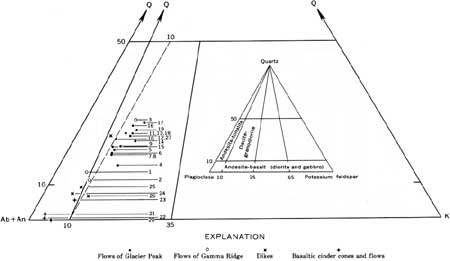
|
| FIGURE 30.—Ternary diagram showing predominant composition of Glacier Peak lavas. Numbers refer to samples listed in table 4. (click on image for an enlargement in a new window) |
TEXTURAL VARIATIONS
Textures in the flows vary considerably. Flow margins and some entire flows are vitrophyric to hyalopilitic (figs. 31, 32). The majority of flows are intersertal to pilotaxitic or trachytic (figs. 33, 34). The lavas of the Disappointment Peak dome are uniformly porphyritic and hyahopilitic. Commonly the brown glass is crowded with crystallites, but intermediate-sized plagioclase phenocrysts are rare. The thin, mostly steeply dipping flows of the summit cone encompass all textural types.
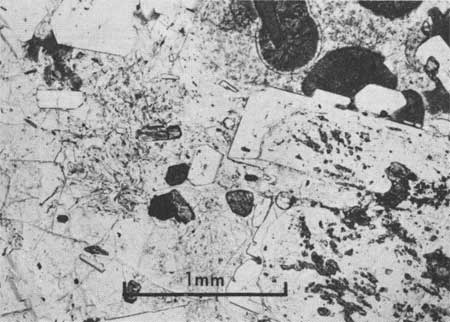
|
| FIGURE 31.—Vitrophyric texture in dacite on ridge south of Chocolate Creek. Note spherulites. Plane-polarized light. Specimen. DFC—184—62. |
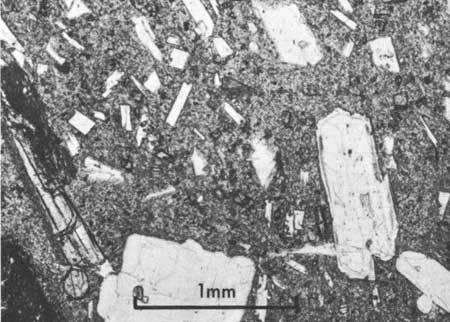
|
| FIGURE 32.—Hyalopilitic texture in dacite from north rim of crater. Plane-polarized light. Specimen 721569AF. |
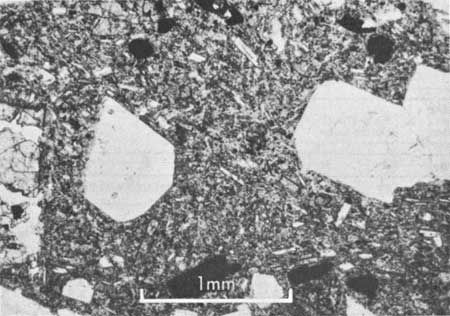
|
| FIGURE 33.—Intersertal texture in dacite from south of upper Suiattle River. Plane-polarized light. Specimen RWT—188—62. |
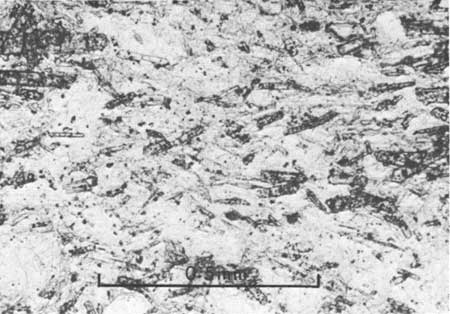
|
| FIGURE 34.—Flow-banded pilotaxitic texture in dacite from flow capping Vista Ridge. Plane-polarized light Specimen DFC—220—61. |
TABLE 4.—Composition of eruptive rocks and dikes in the Glacier Peak area.
[Samples, sawed from hand specimens (except pyroclastic rocks); small, homogeneous, and fresh, except as noted. Locations of samples are shown on plate 1, except for sample 17. Oxides: Weight percentages by X-ray fluorescence supplemented by methods described by U.S. Geological Survey Bulletin 1144—A. Analysts: Paul L. D. Elmore, Samual Botts, Gillison Chloe, Lowell Artis, and H. Smith]
| Gamma Ridge lavas | Glacier Peak lava flows |
Glacier Peak pyroclastic and clastic rocks |
Cinder cones and flows |
Dikes and flows | |||||||||||||||||||||||||||
| Principal flows | Disappointment Peak dome | Vitric tuff | Pumice | Other tuff | Suiattle fill(?) | Indian Pass cinder cone | White Chuck Cinder Cone | Lightning Creek flow | |||||||||||||||||||||||
| 1 | 2 | 3 | 4 | 5 | 6 | 7 | 8 | 9 | 10 | 11 | 12 | 13 | 14 | 15 | 16 | 17 | 18 | 19 | 20 | 21 | 22 | 23 | 24 | 25 | 26 | 27 | |||||
| Symbol on plate 1 | Tgf | Tgf | Tgf | Qdc | Qdu | Qdu | Qdc | Qdc | Qds | Qdc | Qdc | Qdb | Qdd | Qdd | Qvt | Overprint | ----- | ----- | ----- | Qcb | Qcl | Qbl | Not shown on plate 1 | ||||||||
Weight percent of oxides | |||||||||||||||||||||||||||||||
| SiO2 | 55.4 | 57.0 | 64.2 | 60.3 | 62.1 | 62.3 | 62.3 | 62.4 | 63.4 | 63.9 | 61.0 | 65.3 | 64.7 | 65.9 | 63.5 | 65.1 | 65.5 | 65.7 | 66.3 | 49.9 | 50.8 | 51.0 | 55.3 | 52.7 | 54.7 | 56.8 | 62.7 | ||||
| A12O3 | 17.5 | 18.0 | 16.1 | 16.6 | 17.3 | 17.6 | 17.6 | 17.6 | 16.7 | 16.5 | 16.5 | 16.5 | 16.7 | 16.5 | 17.2 | 16.7 | 16.0 | 16.3 | 16.4 | 17.1 | 18.2 | 18.2 | 16.5 | 17.8 | 17.4 | 18.0 | 17.2 | ||||
| Fe2O3 | 3.0 | 1.9 | 3.2 | 2.3 | 2.0 | 1.6 | 1.6 | 1.6 | 1.6 | 1.7 | 2.0 | 1.2 | 3.4 | 1.7 | 2.0 | 1.4 | 1.2 | 1.5 | 1.4 | 2.1 | 2.6 | 2.7 | 1.3 | 7.4 | 1.9 | 2.6 | 3.1 | ||||
| FeO | 2.1 | 4.2 | .84 | 3.0 | 3.0 | 3.2 | 3.3 | 3.4 | 3.2 | 2.4 | 1.9 | 2.9 | .95 | 2.3 | 2.3 | 2.2 | 1.9 | 2.4 | 2.4 | 5.4 | 5.5 | 5.4 | 5.2 | .60 | 4.8 | 4.2 | 1.0 | ||||
| MgO | 4.9 | 4.9 | 2.3 | 4.1 | 3.0 | 3.0 | 2.8 | 2.9 | 2.9 | 3.4 | 2.4 | 2.4 | 2.6 | 2.2 | 2.2 | 2.1 | 1.7 | 1.7 | 2.0 | 9.4 | 7.1 | 7.3 | 7.5 | 6.2 | 5.8 | 3.3 | 2.3 | ||||
| CaO | 6.5 | 7.0 | 4.0 | 5.7 | 5.1 | 5.3 | 4.8 | 5.2 | 4.9 | 5.0 | 4.4 | 4.2 | 4.3 | 4.3 | 4.8 | 2.2 | 3.6 | 3.9 | 4.0 | 8.1 | 9.5 | 9.3 | 7.6 | 9.1 | 8.0 | 6.6 | 4.8 | ||||
| Na2O | 3.7 | 3.6 | 3.8 | 4.0 | 4.0 | 4.0 | 4.4 | 4.0 | 4.0 | 3.9 | 4.1 | 4.1 | 4.0 | 4.1 | 4.4 | 4.8 | 3.9 | 4.5 | 4.1 | 4.0 | 3.0 | 3.2 | 3.5 | 3.3 | 3.2 | 4.7 | 4.2 | ||||
| K2O | 1.0 | 1.2 | 1.8 | 1.9 | 1.6 | 1.6 | 1.6 | 1.6 | 1.8 | 1.6 | 1.8 | 2.0 | 2.0 | 2.0 | 1.7 | 1.8 | 2.2 | 2.3 | 2.1 | .60 | .39 | .41 | .59 | .85 | 1.0 | 1.5 | 1.3 | ||||
| H2O+ | 1.5 | 1.1 | 1.1 | .85 | .72 | .71 | .40 | .58 | .76 | .73 | .79 | .81 | .55 | .46 | .69 | 1.8 | 2.69 | .38 | .78 | .89 | .48 | .63 | .49 | .51 | .83 | .51 | 1.1 | ||||
| H2O— | 3.0 | .25 | 1.7 | .27 | .27 | .15 | .20 | .14 | .18 | .18 | .52 | .01 | .12 | .08 | .21 | .43 | .79 | .23 | .07 | .61 | .27 | .22 | .06 | .14 | .77 | .14 | 1.4 | ||||
| TiO2 | .91 | .78 | .57 | .80 | .67 | .67 | .68 | .65 | .66 | .67 | .59 | .58 | .57 | .54 | .61 | .53 | .43 | .61 | .51 | 1.20 | 1.1 | 1.1 | 1.1 | .78 | .92 | 1.2 | .51 | ||||
| P2O5 | .22 | .23 | .15 | .35 | .17 | .15 | .16 | .15 | .15 | .19 | .17 | .13 | .12 | .12 | .16 | .13 | .12 | .15 | .12 | .39 | .18 | .18 | .26 | .29 | .23 | .25 | .13 | ||||
| MnO | .12 | .3 | .07 | .11 | .11 | .11 | .12 | .11 | .11 | .09 | .09 | .10 | .11 | .10 | .14 | .12 | .07 | .10 | .10 | .14 | .14 | .16 | .12 | .17 | .12 | .12 | .12 | ||||
| CO2 | .11 | <.05 | .06 | <.05 | <.05 | <.05 | <.05 | <.05 | <.05 | <.05 | <.05 | <.05 | <.05 | <.05 | .08 | <.05 | .09 | <.05 | .08 | <.05 | .15 | <.05 | .08 | .16 | .05 | .05 | |||||
| Total | 100.00 | 100.3 | 99.9 | 100.3 | 100.1 | 100.4 | 99.9 | 100.4 | 100.4 | 100.3 | 100.3 | 100.4 | 100.2 | 100.4 | 100.0 | 99.4 | 99.9 | 100.0 | 100.3 | 100.0 | 99.3 | 100.0 | 100.0 | 100.0 | 100.8 | 100.0 | 100.0 | ||||
Normative composition (CIPW) | |||||||||||||||||||||||||||||||
| Q | 10.1 | 8.3 | 23.8 | 12.2 | 16.4 | 15.8 | 14.8 | 16.1 | 17.4 | 19.1 | 21.3 | 20.0 | 21.0 | 21.3 | 17.7 | 21.8 | 23.7 | 19.5 | 22.0 | 0.9 | 0.3 | 3.5 | 5.0 | 6.4 | 5.3 | 20.0 | |||||
| C | 1.1 | .1 | .3 | .2 | .2 | .3 | .4 | .1 | 3.2 | .9 | .4 | .5 | |||||||||||||||||||
| Or | 5.9 | 7.1 | 10.6 | 11.2 | 9.5 | 9.5 | 9.5 | 9.5 | 10.6 | 9.5 | 10.6 | 11.8 | 11.8 | 11.8 | 10.0 | 10.6 | 13.0 | 13.6 | 12.4 | 3.6 | 2.3 | 2.4 | 5.6 | 5.0 | 5.9 | 8.9 | 7.7 | ||||
| Ab | 31.3 | 30.5 | 32.2 | 33.9 | 33.9 | 33.9 | 37.2 | 33.9 | 33.9 | 33.0 | 34.7 | 34.7 | 33.9 | 34.7 | 37.2 | 40.6 | 32.7 | 38.1 | 34.7 | 33.9 | 25.4 | 27.1 | 29.6 | 27.9 | 27.1 | 39.8 | 35.5 | ||||
| An | 28.2 | 29.4 | 18.5 | 21.7 | 24.2 | 25.3 | 22.8 | 24.8 | 22.3 | 22.8 | 20.7 | 20.0 | 20.6 | 20.6 | 22.2 | 10.1 | 17.3 | 17.5 | 19.1 | 26.9 | 35.0 | 34.1 | 26.5 | 31.3 | 30.2 | 23.6 | 23.0 | ||||
| Wo | .8 | 1.6 | 1.8 | .4 | .3 | .1 | 4.3 | 4.6 | 4.1 | 4.0 | 4.8 | 2.9 | 3.1 | ||||||||||||||||||
| En | 12.2 | 12.2 | 5.7 | 10.2 | 7.5 | 7.5 | 7.0 | 7.2 | 7.2 | 8.5 | 6.0 | 6.0 | 6.5 | 5.5 | 5.5 | 5.2 | 4.2 | 4.2 | 5.0 | 5.6 | 17.7 | 18.2 | 18.7 | 15.4 | 14.4 | 8.2 | 5.7 | ||||
| Fo | 12.5 | ||||||||||||||||||||||||||||||
| Fa | 3.9 | ||||||||||||||||||||||||||||||
| Fs | .1 | 5.1 | 2.5 | 3.0 | 3.7 | 3.8 | 4.1 | 3.7 | 2.1 | 1.0 | 3.6 | 2.1 | 1.8 | 2.2 | 1.9 | 2.4 | 2.6 | 1.5 | 6.4 | 6.2 | 6.9 | 6.0 | 3.8 | ||||||||
| Mt | 4.4 | 2.8 | 1.3 | 3.3 | 2.9 | 2.3 | 2.3 | 2.3 | 2.3 | 2.5 | 2.9 | 1.7 | 1.8 | 2.5 | 2.9 | 2.0 | 1.7 | 2.2 | 2.0 | 3.1 | 3.8 | 3.9 | 1.9 | .2 | 2.8 | 3.8 | 2.1 | ||||
| Hm | 2.3 | 2.2 | 7.2 | 1.6 | |||||||||||||||||||||||||||
| Il | 1.7 | 1.5 | 1.1 | 1.5 | 1.3 | 1.3 | 1.3 | 1.2 | 1.3 | 1.3 | 1.1 | 1.1 | 1.1 | 1.0 | 1.2 | 1.0 | .8 | 1.2 | 1.0 | 2.3 | 2.1 | 2.1 | 2.1 | 1.5 | 1.8 | 2.3 | 1.0 | ||||
| Ap | .5 | .5 | .4 | .8 | .4 | .4 | .4 | .4 | .4 | .5 | .4 | .3 | .3 | .3 | .4 | .3 | .3 | .4 | .3 | .9 | .4 | .4 | .6 | .7 | .6 | .6 | .3 | ||||
| Cc | .3 | .1 | .2 | .2 | .2 | .3 | .2 | .4 | |||||||||||||||||||||||
| Total | 95.2 | 99.0 | 94.7 | 99.2 | 99.1 | 99.5 | 99.4 | 99.6 | 99.4 | 99.4 | 99.0 | 99.4 | 97.3 | 99.8 | 98.9 | 97.1 | 96.5 | 99.1 | 99.4 | 82.0 | 98.5 | 98.8 | 99.4 | 91.9 | 97.9 | 99.3 | 95.8 | ||||
| Salic | 75.5 | 75.3 | 86.2 | 79.0 | 84.1 | 84.5 | 84.6 | 84.4 | 84.2 | 84.3 | 87.5 | 86.7 | 87.7 | 88.4 | 87.1 | 86.3 | 87.7 | 88.7 | 88.6 | 64.3 | 63.6 | 63.9 | 65.2 | 69.2 | 69.5 | 77.5 | 86.6 | ||||
| Femic | 20.0 | 23.7 | 10.9 | 20.2 | 15.0 | 15.1 | 14.8 | 15.2 | 15.3 | 15.0 | 11.4 | 12.7 | 11.8 | 11.4 | 12.0 | 10.8 | 8.9 | 10.6 | 10.9 | 34.1 | 34.9 | 35.3 | 34.1 | 30.1 | 28.7 | 21.8 | 10.8 | ||||
| Total plag | 59.5 | 59.9 | 50.7 | 55.6 | 58.1 | 59.2 | 60.0 | 58.7 | 56.2 | 55.8 | 55.4 | 54.7 | 54.4 | 55.3 | 59.4 | 50.7 | 50.0 | 55.6 | 53.8 | 60.8 | 60.4 | 61.2 | 56.1 | 59.2 | 57.3 | 63.4 | 58.5 | ||||
| Percent An in plagioclase | 48.6 | 49.1 | 36.7 | 39.0 | 41.7 | 42.8 | 37.9 | 42.3 | 39.8 | 40.8 | 37.4 | 36.7 | 37.7 | 36.4 | 37.3 | 20.8 | 34.6 | 31.5 | 35.4 | 43.4 | 58.1 | 55.8 | 47.2 | 52.8 | 52.8 | 37.3 | 39.3 | ||||
Trace element content1 | |||||||||||||||||||||||||||||||
| Ba | 500 | 500 | 700 | 1,000 | 500 | 700 | 500 | 500 | 700 | 700 | 700 | 500 | 700 | 700 | 700 | 700 | 700 | 700 | 500 | 150 | 200 | 700 | 500 | 500 | 700 | 500 | |||||
| Be | 0 | <1 | <1 | <1 | <1 | <1 | 1.5 | <1 | <1 | <1 | <1 | <1 | <1 | <1 | 0 | 0 | 0 | <1 | 0 | 0 | 0 | 0 | 0 | 0 | <1 | 0 | |||||
| Ce | 0 | 100 | 0 | 150 | 100 | 100 | 0 | 0 | 0 | 100 | 0 | 0 | 0 | 100 | 0 | 0 | 0 | 0 | 0 | 0 | 0 | 0 | 0 | 0 | 0 | 0 | |||||
| Co | 30 | 30 | 15 | 20 | 15 | 20 | 20 | 15 | 15 | 15 | 15 | 15 | 20 | 15 | 15 | 15 | 15 | 15 | 70 | 50 | 50 | 50 | 50 | 50 | 10 | 30 | |||||
| Cr | 200 | 150 | 70 | 150 | 70 | 70 | 50 | 50 | 50 | 100 | 50 | 30 | 50 | 50 | 30 | 20 | 30 | 20 | 700 | 500 | 300 | 700 | 150 | 300 | 300 | 150 | |||||
| Cu | 70 | 30 | 15 | 70 | 30 | 70 | 15 | 20 | 30 | 20 | 30 | 10 | 20 | 20 | 15 | 7 | 10 | 15 | 50 | 50 | 50 | 50 | 100 | 50 | 15 | 50 | |||||
| Ga | 15 | 15 | 15 | 15 | 20 | 20 | 15 | 15 | 15 | 15 | 15 | 7 | 15 | 15 | 15 | 15 | 10 | 15 | 15 | 10 | 15 | 15 | 15 | 15 | 15 | 15 | |||||
| La | 0 | 0 | 0 | 50 | 0 | 0 | 0 | 0 | 0 | 30 | 0 | 0 | 0 | 0 | 0 | 0 | 0 | 0 | 0 | 0 | 0 | 0 | 0 | 0 | 0 | 0 | |||||
| Mo | 0 | <3 | 0 | 3 | 3 | 3 | 0 | 3 | 3 | <3 | <3 | 3 | 3 | 3 | 0 | 0 | 0 | 3 | 0 | 0 | 0 | 0 | 0 | 0 | 0 | 0 | |||||
| Nb | 0 | 3 | 0 | 5 | 3 | 3 | 0 | 3 | 5 | 3 | 5 | 3 | 3 | 3 | 0 | 0 | 0 | 7 | 0 | 0 | 0 | 0 | 0 | 0 | 0 | 0 | |||||
| Ni | 100 | 150 | 50 | 100 | 50 | 30 | 50 | 100 | 50 | 70 | 30 | 20 | 30 | 30 | 30 | 20 | 30 | 30 | 700 | 150 | 150 | 500 | 50 | 70 | 15 | 50 | |||||
| Pb | 0 | 15 | 0 | 200 | 20 | 100 | 0 | 150 | 30 | 30 | 15 | 10 | 15 | 200 | 0 | 0 | 0 | 15 | 0 | 0 | 0 | 0 | 0 | 0 | 0 | 0 | |||||
| Sc | 30 | 20 | 20 | 20 | 15 | 15 | 20 | 15 | 15 | 10 | 10 | 15 | 15 | 15 | 20 | 15 | 15 | 10 | 30 | 50 | 50 | 30 | 70 | 30 | 15 | 30 | |||||
| Sn | 0 | 0 | 0 | 7 | 0 | 7 | 0 | 7 | 0 | 0 | 0 | 7 | 0 | 7 | 0 | 0 | 0 | 0 | 0 | 0 | 0 | 0 | 0 | 0 | 0 | 0 | |||||
| Sr | 1,000 | 1,500 | 700 | 200 | 1,000 | 1,000 | 700 | 1,500 | 1,000 | 1,500 | 1,500 | 700 | 1,000 | 1,050 | 700 | 700 | 500 | 1,000 | 1,500 | 700 | 700 | 1,000 | 1,500 | 1,000 | 1,000 | 1,000 | |||||
| V | 300 | 150 | 150 | 150 | 150 | 150 | 200 | 150 | 150 | 100 | 100 | 100 | 150 | 150 | 150 | 7 | 150 | 100 | 500 | 200 | 700 | 500 | 700 | 500 | 300 | 150 | |||||
| Y | 20 | 15 | 20 | 20 | 20 | 20 | 20 | 15 | 15 | 10 | 10 | 15 | 15 | 15 | 20 | 20 | 20 | 15 | 30 | 30 | 30 | 30 | 20 | 20 | 15 | 30 | |||||
| Yb | 2 | 15 | 2 | 15 | 2 | 3 | 2 | 1 | 1.5 | 1 | 1 | 1.5 | 1.5 | 1.5 | 2 | 2 | 2 | 2 | 3 | 3 | 3 | 3 | 3 | 2 | 1.5 | 3 | |||||
| Zr | 130 | 200 | 150 | 200 | 200 | 200 | 150 | 200 | 200 | 200 | 150 | 200 | 200 | 250 | 100 | 150 | 200 | 200 | 150 | 100 | 100 | 200 | 150 | 100 | 150 | 200 | |||||
1Semiquantitative spectrographic analysis in parts per million. Results are reported in percent to the nearset number in the series 1, 0, 7, 0.5, 0.3, 0.2, 0.15, and 0.1, which represent approximate midpoints of group data on a geometric scale. The assigned group for about 30 percent of semiquantitative results will include the quantitative value. Standard sensitivities in ppm are: Ag, 1; As, 500; Au, 30; B, 10; Ba, 10; Be, 1; Bi, 10; Cd, 50; Ce, 200; Co, 5; Cr, 1; Cu, 1; Ga, 10; Ge, 10; Hf, 300; Hg, 1,000; In, 10; La, 30; Li, 500; Mo, 5; Nb, 50; Ni, 5; Pb, 10; Pd, 3; Pt, 10; Re, 50; Sb, 100; Sc, 1; Sn, 20; Sr, 10; Ta, 400; Te, 1,000; Tb, 500; Tl, 50; U, 500; V, 10; W, 500; Y 10; Yb, 1; Zn, 200; and Zr, 10. Elements looked for and not found are: Ag, As, Au, Bi, Cd, Ge, Hf, Hg, In, Li, Pd, Pt, Re, Sb, Ta, Te, Tb, Tl, U, W, and Zn. Analysts, I. H. Barlow and Chris Heropoulos. 1. Andesite, altered, amygdaloidal; north side lower Dusty Creek.2. Olivine andesitic dacite; upper Milk Creek. 3. Dacite, altered; north side lower Dusty Creek. 4. Olivine pyroxene dacite; Backos Creek; medium-sized sample. 5. Pyroxene dacite; upper Sitkum Creek; phenocrysts irregularly distributed. 6. Pyroxene dacite; north side Kennedy Creek; phenocrysts irregularly distributed. 7. Pyroxene dacite; northwest Ptarmigan Glacier. 8. Replicate of sample 7. 9. Pyroxene dacite; nose of Glacier Ridge; phenocrysts irregularly distributed. 10. Pyroxene dacite; Vista Ridge; phenocrysts irregularly distributed, cut by weathered fractures. 11. Pyroxene dacite; east fork Milk Creek; phenocrysts irregularly distributed. 12. Pyroxene dacite vitrophyre; south side Vista Creek; phenocrysts irregularly distributed. 13. Oxyhornblende-hypersthene dacite; Disappointment Peak, oxidized red. 14. Oxyhornblende-hypersthene dacite; Disappointment Peak; medium-sized sample; some diktytaxitic inclusions. 15. Vitric tuff; mouth of Glacier Creek; large sample; may contain dacite inclusions. 16. Hornblende dacite pumice; upper Suiattle River; large sample; slightly weathered. 17. Hornblende dacite pumice; mouth of Phelps Creek, Holden quadrangle. From Czamanske and Porcer (1963). 18. Pyroxene pumaceous tuff; upper Suiattle River; crumbly; layered; large-sized sample. 19. Pyroxene dacite breadcrust bomb; north of Disappointment Peak. 20. Olivine basalt; Indian Pass cinder cone; feeder dike, slightly weathered. 21. Olivine basalt; White Chuck Cinder Cone; flow; medium-sized sample; slightly weathered; phenocrysts irregularly distributed. 22. Olivine basalt; White Chuck Cinder Cone; cinders. 23. Olivine andesite; mouth of Lightning Creek. 24. Pyroxene andesite; north of Reflection Pond on Cascade Crest; medium-sized sample; oxidized red. 25. Pyroxene andesite; on Cascade Crest at head of Lightning Creek; some small inclusions. 26. Andesite; upper Napeequa River, Northeast of Tenpeak; medium-sized sample; 27. Hornblende dacite; 2 miles south of Mackinaw Shelter on ridge crest west of north fork of Sauk; medium-sized sample; slightly weathered. | |||||||||||||||||||||||||||||||
Most of the thick flows now exposed as ridge cappings or as remnants on valley sides are pilotaxitic, but many are holocrystalline. Irregular patches of a holocrystalline mesostasis of sodic feldspar and (or) alkalic feldspar, quartz, and scattered flakes of pale-brown biotite are characteristic of these flows (figs. 35, 36). These patches appear devitrified, but as similar patches occur in flows of all ages, they may not be time dependent. Perhaps they are related to conditions during cooling, such as local accumulations of volatiles. Similar holocrystalline patches are common in the flows of Mount Rainier (C. A. Hopson, oral commun., 1965).
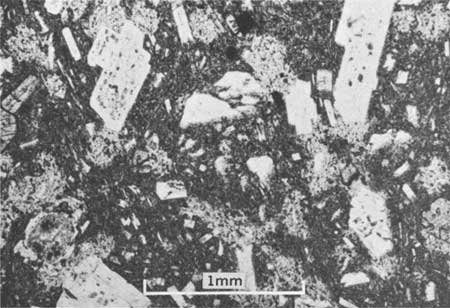
|
| FIGURE 35.—Patches of fine-grained holocrystalline groundmass in flow of dacite from side of Glacier Ridge. Plane-polarized light. Specimen DFC—116—61. |
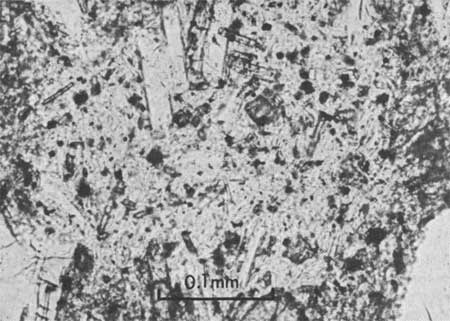
|
| FIGURE 36.—Specimen DFC—220—61 (dacite in fig. 34) showing holocrystalline mesostasis of sodic feldspar and quartz with small biotite flakes (circular black spots with indistinct margins). Plane-polarized light. |
| <<< Previous | <<< Contents >>> | Next >>> |
/pp/604/sec3c.htm
Last Updated: 28-Mar-2006